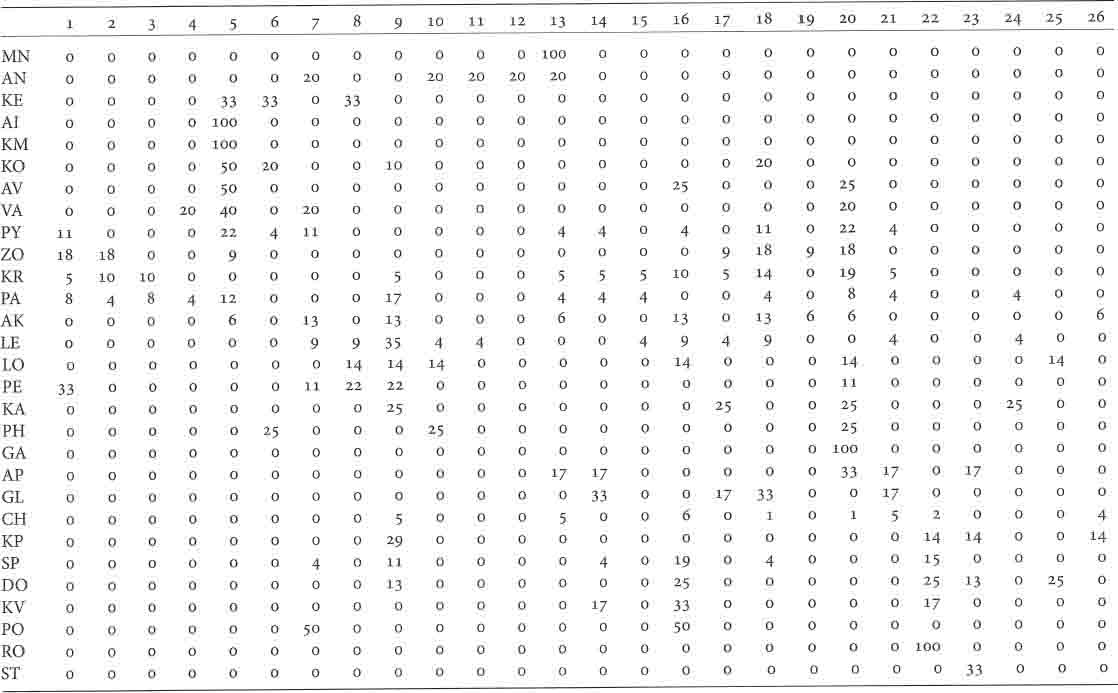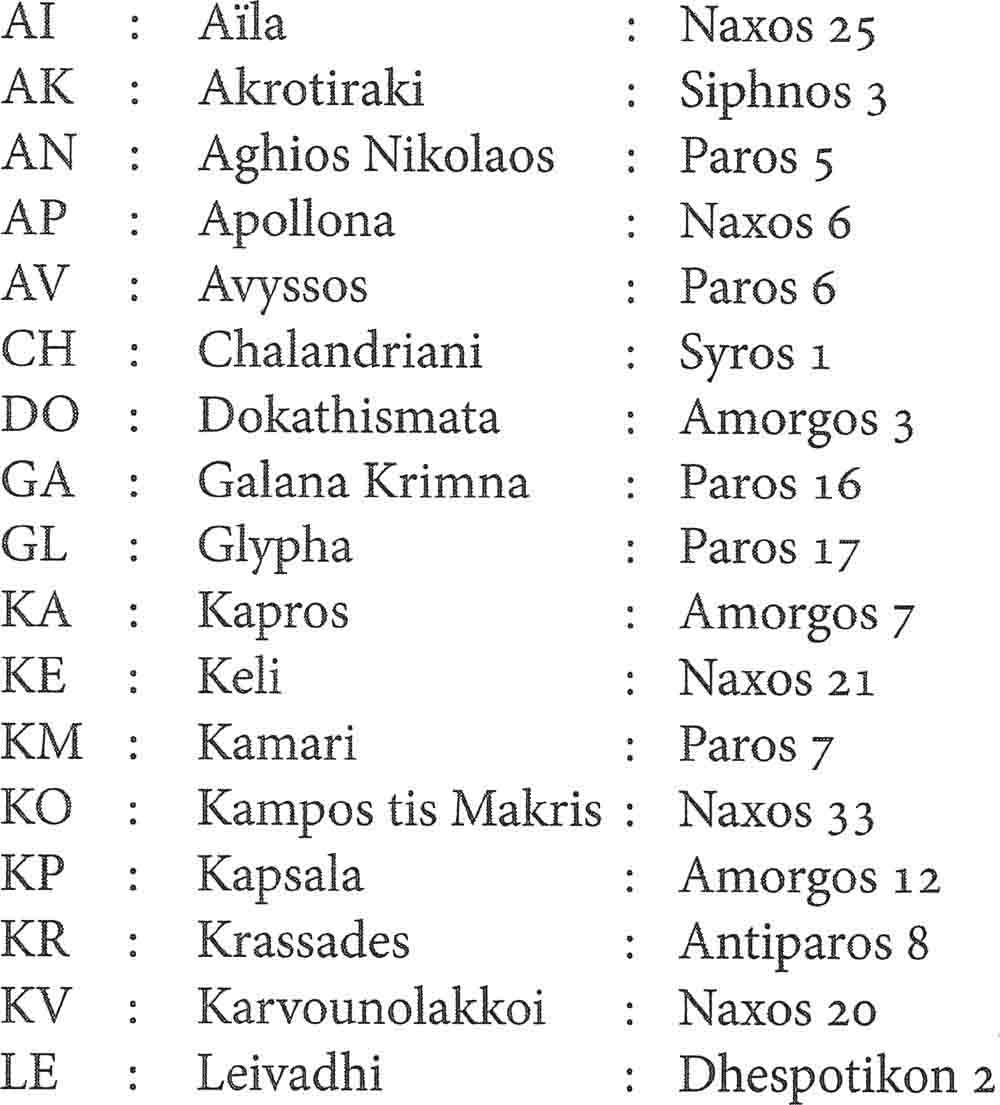
The purpose of the matrix analysis was discussed in chapter 10, and the method used was outlined there. To avoid encumbering the text of that chapter with the full data, the matrices themselves are given here, together with a list of the cemeteries considered and of the types which were defined for the analysis.
The abbreviations used for the cemeteries (and their number in the Gazetteer list in Appendix 1) are as follows:

Reference to the original publication of the finds from these cemeteries is given in the Gazetteer. Although this list covers only some of the Early Cycladic cemeteries known, these are the only ones for which detailed data have been published.
Abbreviations: Tc indicates pottery; M, marble; Cu, copper or bronze; In the references, Z refers to Zervos 1956, Pap. to Papathanasopoulos 1961-62, and Tsountas to Tsountas 1898. Other references are to the present work.
| Type | Description | Reference |
| 1 | Tc Hole-mouthed jar with pierced suspension lugs and incised decoration | Z pls. 61-62; pl. 3, 2 |
| 2 | Tc Hole-mouthed jar with pierced suspension lugs, undecorated | Z pl. 64, 71; pl. 3,3 |
| 3 | Tc Footed jar, similar, incised decoration | Z pl. 73; pl. 3, 1 |
| 4 | Tc Footed jar, similar, undecorated | Z pl. 66; fig. 10.3, 2 |
| 5 | Tc Cylindrical pyxis, incised decoration | Z pl. 74, 83; fig. 10.3, 1 |
| 6 | Tc Cylindrical pyxis, undecorated | Pap. pl. 71 |
| 7 | Tc Spherical pyxis, incised decoration | Z pls. 81-82; fig. 10.3, 3 |
| 8 | Tc Spherical pyxis, undecorated | Pap. pl. 67 |
| 9 | Obsidian (whether blade or core) | Z pl. 32 |
| 10 | Tc ‘frying pan’ of Kampos type | Z pls. 224-27; pl. 4, 1 |
| 11 | Tc Globular bottle with incised decoration | Z pls. 86-88; pl. 5, 3 |
| 12 | M Footed cup, convex sided | Z pl. 18; fig. 11.1, 4 |
| 13 | Stone palette or rectangular stone | Z pl. 15 |
| 14 | M Footed jar with horizontally pierced lugs (kandila) | Z pls. 6-8; fig. 10.3, 4 |
| 15 | M Flat based beaker or rhyton with horizontally pierced lugs | Z pl. l, 2; fig. 10.4, 3 |
| 16 | M Bowl or saucer of simple profile | Z pl 4, 5 |
| 17 | M Figurine of Plastiras type | Z pl. 112; pl. 2, 2-3 |
| 18 | M Schematic figurine | Z pls. 57-58; pl. 2, 4-5 |
| 19 | Stone, bird bead | Z pl. 257 |
| 20 | Stone, other beads | Tsountas pl. 8, 20-65 |
| 21 | Stone rubber | Tsountas pl. 8, 12 |
| 22 | M Folded-arm figurine | cf. pls. 30-31 |
| 23 | Cu Dagger or spearhead | pl. 22, 6-10 |
| 24 | Cu Flat axe (or wire) | Pap. pl. 77 |
| 25 | Silver object | Pap. pl. 67 |
| 26 | Cu Tweezers | Z pl. 261; fig. 11.3 |
| 27 | Tc Jug, undecorated | Pap. pl. 51 |
| 28 | Shell or shells | Pap. pl. 52 |
| 29 | Red colouring matter | |
| 30 | Tc Footed cup, convex sided, with painted decoration | Z pls. 240-41; fig. 11.1, 9 |
| 31 | Tc Jug, painted decoration | Z pl. 117; pl. 7, 3 |
| 32 | Tc Pyxis (spherical or cylindrical) painted decoration | Z pls. 233-37; pl 7,2 |
| 33 | Tc ‘frying pan’ of Syros type | Z pls. 204-5; fig. 11.1, 10 |
| 34 | Tc Footed jar of Syros type, with defined neck, stamped decoration | Z pls. 201, 203; fig. 11.1, 1 |
| 35 | Tc Other vessels with stamped decoration | Z pls. 199-200 |
| 36 | Tc Spherical pyxis of Syros type, undecorated | fig. 11.1, 3 |
| 37 | Tc Footed jar of Syros type, undecorated | pl. 8, 11 |
| 38 | Tc Footed cup, concave sided, undecorated | Z pl. 187 |
| 39 | Tc Footed cup, convex sided, undecorated | Tsountas 1899, pl. 9, 12 |
| 40 | Tc Cup or small bowl, convex sided, undecorated | Tsountas 1899, pl. 9, 26 |
| 41 | M Footed cup, concave sided | Z pl. 49; fig. 11.1, 4 |
| 42 | M Pyxis, spherical or rounded | Z pl. 21 |
| 43 | M Spouted bowl | Z pl. 14; fig. 11.1, 8 |
| 44 | Bone tube with incised decoration | Z pl. 262 |
| 45 | Bone bird-headed pin | Z pl. 256 |
| 46 | Cu Spatula | Z pl. 260; fig. 11.3 |
| 47 | Cu Knot-headed or knob-headed pin | Z pl. 261; fig. 11.3 |
| 48 | Cu Double-spiral-headed pin | Z pl. 261; fig. 11.3 |
| 49 | Cu Awl of rectangular section | Pap. pl. 68 |
| 50 | Cu Needle | Z pl. 261 |
| 51 | Blue colouring matter (azurite) | |
| 52 | Other Bone object | |
| 53 | M Footed jar of Syros type | Z pl. 10 |
TABLE APP. 3.1. Incidence matrix for the occurrence of the different types of grave goods found in the Early Cycladic cemeteries. The first figure indicates the number of different graves in which the type in question is found, the second figure the total number of occurrences of the type in the cemetery in question. The key for the cemetery abbreviations is given on p. 539, and the type numbers at the head of the columns are explained on p. 540.
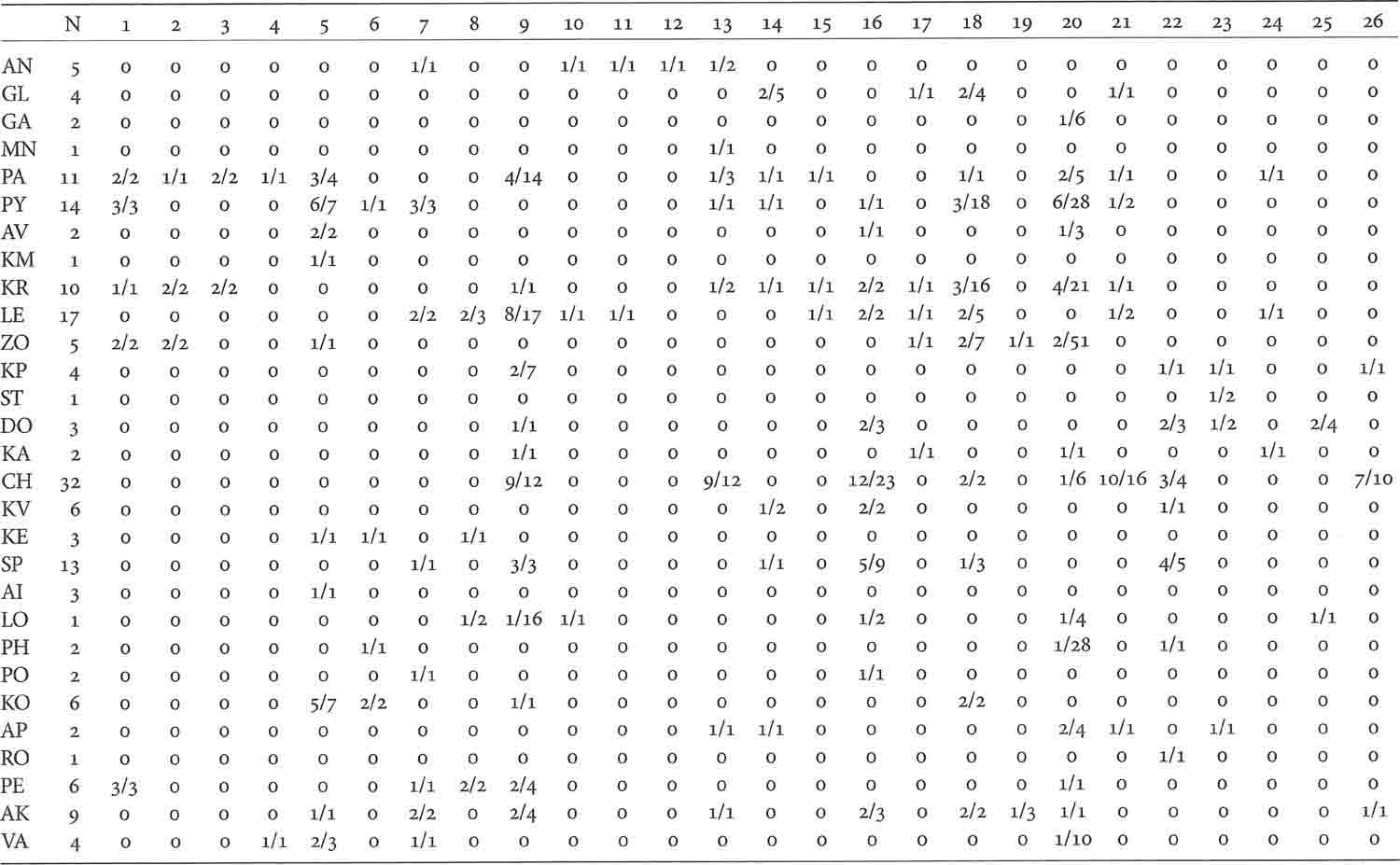
Note: It was possible to include only such data as were published by the excavator. Sources: Tsountas 1898, Tsountas 1899; Varoucha 1926; Papathanasopoulos 1961–62; Edgar 1897.
TABLE APP.3.2. Unordered presence-absence similarity coefficient matrix for the Early Cycladic cemeteries. The figure indicates in each case the number of types the two cemeteries have in common, irrespective of the number of times these occur in each cemetery. Cemeteries as listed for Table App. 3.1.
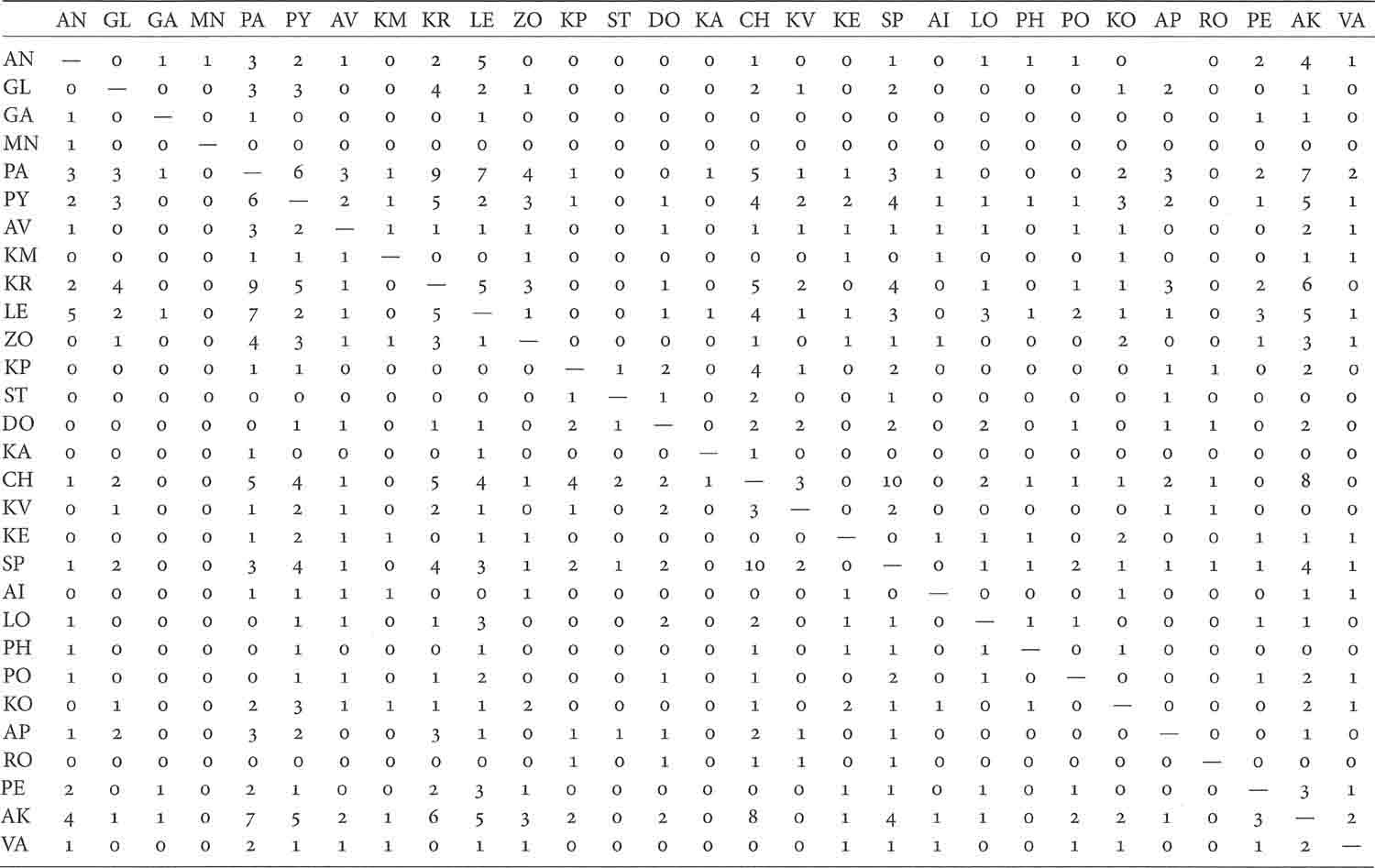
TABLE APP.3.3. Percentile similarity coefficient matrix for the Early Cycladic cemeteries, as ordered by the computer, using the Kuzara-Mead-Dixon program for Robinson-Brainerd seriation. Cemeteries as listed for Table App. 3.3.
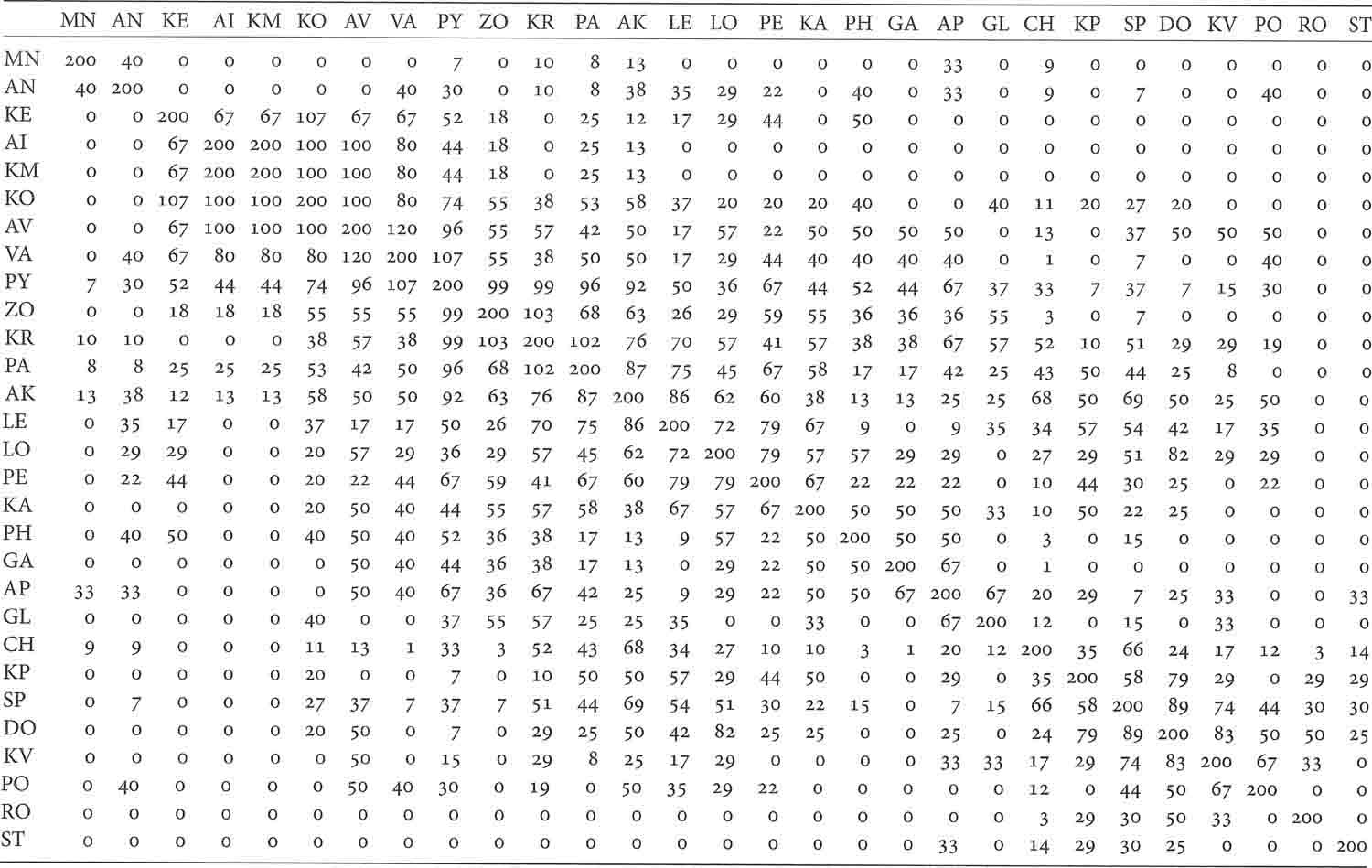
TABLE APP.3.4. Percentile incidence matrix for the Early Cycladic cemeteries, ordered by the computer in the ordering presented in Table App. 3.3. The percentage in each case indicates the contribution made by the type in question to the total for the cemetery. (The total occurrence of type, and not simply their presence as in Table App. 3.2, is taken into account.) Early types are on the left. Cemeteries and types as listed for Table App. 3.1.
